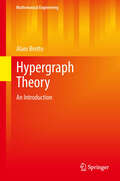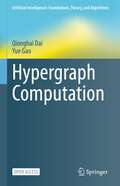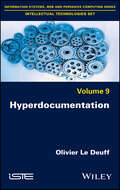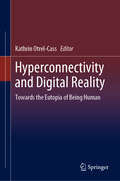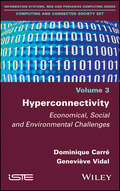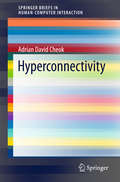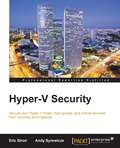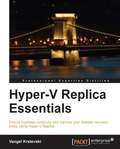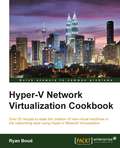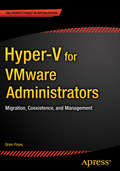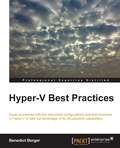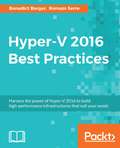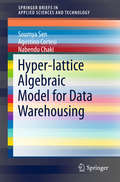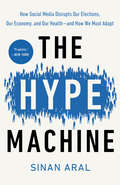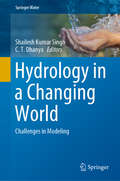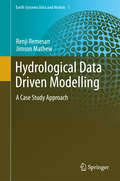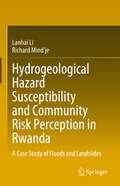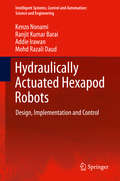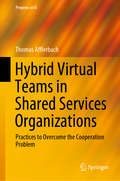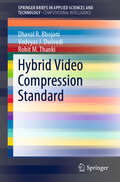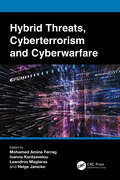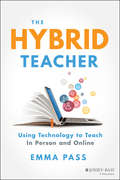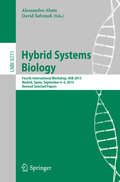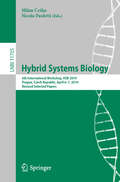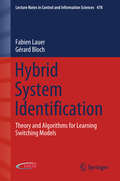- Table View
- List View
Hypergraph Theory
by Alain BrettoThis book provides an introduction to hypergraphs, its aim being to overcome the lack of recent manuscripts on this theory. In the literature hypergraphs have many other names such as set systems and families of sets. This work presents the theory of hypergraphs in its most original aspects, while also introducing and assessing the latest concepts on hypergraphs. The variety of topics, their originality and novelty are intended to help readers better understand the hypergraphs in all their diversity in order to perceive their value and power as mathematical tools. This book will be a great asset to upper-level undergraduate and graduate students in computer science and mathematics. It has been the subject of an annual Master's course for many years, making it also ideally suited to Master's students in computer science, mathematics, bioinformatics, engineering, chemistry, and many other fields. It will also benefit scientists, engineers and anyone else who wants to understand hypergraphs theory.
Hypergraph Computation (Artificial Intelligence: Foundations, Theory, and Algorithms)
by Qionghai Dai Yue GaoThis open access book discusses the theory and methods of hypergraph computation. Many underlying relationships among data can be represented using graphs, for example in the areas including computer vision, molecular chemistry, molecular biology, etc. In the last decade, methods like graph-based learning and neural network methods have been developed to process such data, they are particularly suitable for handling relational learning tasks. In many real-world problems, however, relationships among the objects of our interest are more complex than pair-wise. Naively squeezing the complex relationships into pairwise ones will inevitably lead to loss of information which can be expected valuable for learning tasks. Hypergraph, as a generation of graph, has shown superior performance on modelling complex correlations compared with graph. Recent years have witnessed a great popularity of researches on hypergraph-related AI methods, which have been used in computer vision, social media analysis, etc. We summarize these attempts as a new computing paradigm, called hypergraph computation, which is to formulate the high-order correlations underneath the data using hypergraph, and then conduct semantic computing on the hypergraph for different applications. The content of this book consists of hypergraph computation paradigms, hypergraph modelling, hypergraph structure evolution, hypergraph neural networks, and applications of hypergraph computation in different fields. We further summarize recent achievements and future directions on hypergraph computation in this book.
Hyperdocumentation
by Olivier Le DeuffThe term "hyperdocumentation" is a hyperbole that seems to characterize a paradox. The leading discussions on this topic bring in diverse ideas such as that of data, the fantasy of Big Data, cloud computing, artificial intelligence, algorithmic processing, the flow of information and the outstanding successes of disinformation.The purpose of this book is to show that the current context of documentation is just another step in human construction that has been ongoing for not centuries but millennia and which, since the end of the 19th century, has been accelerating. Coined by Paul Otlet in 1934 in his Traite de Documentation, "hyperdocumentation" refers to the concept of documentation that is constantly being expanded and extended in its functionalities and prerogatives.While, according to Otlet, everything could potentially be documented in this way, increasingly we find that it is our lives that are being hyperdocumented. Hyperdocumentation manifests as an increase not only in the quantity of information that is processed but also in its scope, as information is progressively integrated across areas that were previously poorly documented or even undocumented.
Hyperconnectivity and Digital Reality: Towards the Eutopia of Being Human
by Kathrin Otrel-CassThis book addresses the topic of hyperconnectivity by building on, expanding, and critically examining issues that have to do with information communication technology (ICT) and networked societies. The book explores questions relating to attention and consciousness, techno-capitalism and communicative action taking. Adopting different philosophical angles to assess the challenges we face due to our entanglement with hyperconnected technologies, the book studies performance and performativity in a digitised world by considering the unfolding of our onlife and by looking at what this means to educated future scientists and engineers in a hyperconnected world. The book further discusses digital activities as the new constructs of ourselves and poses questions about how much literacy is needed for us not to be enslaved by those constructs. The book also explores the challenges of hyperconnectivity and the health sector to showcase the vulnerabilities we are increasingly exposed to. It makes clear that - since the boundaries between on- and offline are becoming increasingly blurred - we will require new, flexible frameworks that reconsider what it means to be human in a hyperconnected world.
Hyperconnectivity: Economical, Social and Environmental Challenges
by Dominique Carré Geneviève VidalThe use of digital information and communication technologies would be the traces of a social acceptability of the exploitation of all data, in the context of negotiations of uses. This is the reason why the users present themselves actors and contributors of the hyperconnectivity. We would thus witness a new form of dissemination, inviting user experience and social innovations. It is thus the victory of subordination by negotiated renunciation; A new form of serving, no longer that of the 1980s, with the counters and other services, which have become uncontrolled services - excepted when the users are overcome by restrictive ergonomics, revealing too much the subordination device - which joins the prescription apparently without an injunction. The lure is at its height when users and broadcasters come together to produce the services and goods, composing the business model, until the very existence of the companies, in particular the pure players. Crowdsourcing becomes legitimate: consumers create the content, deliver the data, the basis of the service sold (in a painless way because free access most of the time, indirect financing), the providers make available and administer the service, networks , Interfaces (representing considerable costs), also reputation to attract the attention of other consumers or contributors. In these conditions, the environmental stakes are considerable, so we propose another way of considering them, not as they are dealt with - material and pollution - but according to the prism of the relational practices analyzed in this volume.
Hyperconnectivity
by Adrian David CheokThis book explores the emerging field of hyperconnectivity looking at technology and systems that allow person-to-person and person-to-machine communication in networked organizations and the social and economic impact of this society. The author begins by presenting literary culture and interaction, focusing on the development of the Poetry Mix-Up platform, before looking at electronic and magnetic user interfaces for multisensory experiences. He then offers insights into the controversial topic of human intimacy with robots, looking at recent developments like the Kissinger device amongst others. The author concludes by exploring the potential social impact of hyperconnectivity and its future applications. Hyperconnectivity is essential reading to anyone who wants to deepen their understanding of this emerging field especially researchers, designers and engineers who are interested in multi-platform communication, digital networks and HCI.
Hyper-V Security
by Eric Siron Andy SyrewiczeHyper-V Security is intended for administrators with a solid working knowledge of Hyper-V Server, Windows Server, and Active Directory. An administrator with a functional environment will be able to use the knowledge and examples present in this book to enhance security.
Hyper-V Replica Essentials
by Vangel KrstevskiA fast-paced, step-by-step guide to configuring Hyper-V Replica in various deployment scenarios.a in various deployment scenarios.Hyper-V Replica Essentials is for Windows Server administrators who want to improve their system availability and speed up disaster recovery. You will need experience in Hyper-V deployment because Hyper-V Replica is built in the Hyper-V platform.
Hyper-V Network Virtualization Cookbook
by Ryan BoudIf you are a virtualization architect, engineer, or administrator who wants to leverage Hyper-V to create virtual networks (virtual data centers), this is the book for you. Prior knowledge of Hyper-V or a similar solution and a good understanding of the end goals of creating a virtual network is required.
Hyper-V for VMware Administrators
by Brien PoseyLearn to deploy and support Hyper-V, building on what you know about VMware's vSphere. Whether you're looking to run both hypervisors in parallel or migrate completely, Hyper-V for VMware Administrators has everything you need to get started. The book begins with an overview of Hyper-V basics, including common management tasks such as creating a virtual machine and building a virtual network. You'll learn how to deploy a failover cluster to protect against the risk of Hyper-V becoming a single point of failure, and how to make virtual machines fault tolerant. System Center Virtual Machine Manager (SCVMM) is the preferred tool for managing large Hyper-V deployments, so you'll get to know this next and how it differs from VMware's vCenter solution, as well as how to manage a mixed environment including both vSphere and Hyper-V deployments. Like any server migration, a virtual server migration requires careful planning to ensure success. You'll find information here on the specifics of migrating from vSphere to Hyper-V, planning for down time, IP address differences, performance considerations, and more. For migrations to Hyper-V, SCVMM is once again the preferred tool, but you'll also be introduced to some of the excellent free tools available. One easily overlooked aspect of the migration process is the way in which it impacts your backup and recovery strategy. Knowing the best practices here can help you protect your Hyper-V environment. The book also covers how to monitor and maintain your Hyper-V environment once it's up and running, using features like Cluster-Aware Updating, automated live migrations, and availability sets. The concluding chapter shows you how to take advantage of the efficiencies provided by virtual machine libraries and templates. Approach Hyper-V with confidence, and the knowledge that you've planned for success, with Hyper-V for VMware Administrators. What you'll learn Find out how Hyper-V compares to VMware's vSphere, and how System Center Virtual Machine Manager compares to vCenter. Prevent Hyper-V from becoming a single point of failure with failover clustering. Work with System Center Virtual Machine Manager to manage both Hyper-V and vSphere environments through a single interface. Plan and execute a virtual server migration, including planning for downtime, IP address changes and performance considerations. Adapt your backup and recovery strategy for best results in your new Hyper-V environment. Monitor and maintain your Hyper-V clusters, using Cluster-Aware Updating, automated live migrations, and availability sets. Use virtual machine libraries and templates for increased efficiency. Who this book is for Readers should have a working knowledge of vSphere 5. 5. No prior experience with Hyper-V is expected. Table of Contents Chapter 1: Hyper-V Basics Chapter 2: Building a Failover Cluster Chapter 3: An Introduction to System Center Virtual Machine Manager (SCVMM) Chapter 4: Hyper-V and vSphere Coexistence with SCVMM Chapter 5: Using SCVMM for vSphere Migrations Chapter 6: Other Tools for Migrating Virtual Servers to Hyper-V Chapter 7: Hyper-V Backup Best Practices Chapter 8: Keeping Hyper-V Healthy Chapter 9: Virtual Machine Libraries and Templates
Hyper-V Best Practices
by Benedict BergerThis book is intended for those who already have some basic experience with Hyper-V and now want to gain additional capabilities and knowledge of Hyper-V. If you have used Hyper-V in a lab environment before and now want to close the knowledge gap to transfer your Hyper-V environment to production, this is the book for you!
Hyper-V 2016 Best Practices
by Romain Serre Benedict BergerHarness the power of Hyper-V 2016 to build high-performance infrastructures that suit your needs About This Book * Design and build a reliable and efficient Hyper-V infrastructure. * Fine-tune your Hyper-V performance by adopting network and storage best practices. * Manage, monitor, and protect your workloads with System Center and Microsoft Azure. Who This Book Is For If you are working with Hyper-V and want to optimize its performance and effectiveness, this book is for you. This book will help you close the gap between the Hyper-V lab and production environments. What You Will Learn * Automate and accelerate the deployment of Hyper-V host and nano servers * Create high availability solutions using failover clustering * Design redundant solutions with Hyper-V Replica * Protect your workloads by making a backup or learning disaster recovery * Use the best practices of network and storage * Master the performance and scalability of storage virtualization * Migrate your existing virtualization workloads to Hyper-V2016 * Manage your Hyper-V stack with System Center and Azure * Bridge the gap between the Hyper-V lab and production environment In Detail Hyper-V Server and Windows Server 2016 with Hyper-V provide best-in-class virtualization capabilities. Hyper-V is a Windows-based, very cost-effective virtualization solution with easy-to-use and well-known administrative consoles. This book will assist you in designing, implementing, and managing highly effective and highly available Hyper-V infrastructures. With an example-oriented approach, this book covers all the different tips and suggestions to configure Hyper-V and provides readers with real-world proven solutions. This book begins by deploying single clusters of High Availability Hyper-V systems including the new Nano Server. This is followed by steps to configure the Hyper-V infrastructure components such as storage and network. It also touches on necessary processes such as backup and disaster recovery for optimal configuration. The book does not only show you what to do and how to plan the different scenarios, but it also provides in-depth configuration options. These scalable and automated configurations are then optimized via performance tuning and central management ensuring your applications are always the best they can be. Style and approach This book covers Hyper-V best practices in a step-by-step manner with clear and concise examples.
Hyper-lattice Algebraic Model for Data Warehousing
by Soumya Sen Agostino Cortesi Nabendu ChakiThis book presents Hyper-lattice, a new algebraic model for partially ordered sets, and an alternative to lattice. The authors analyze some of the shortcomings of conventional lattice structure and propose a novel algebraic structure in the form of Hyper-lattice to overcome problems with lattice. They establish how Hyper-lattice supports dynamic insertion of elements in a partial order set with a partial hierarchy between the set members. The authors present the characteristics and the different properties, showing how propositions and lemmas formalize Hyper-lattice as a new algebraic structure.
The Hype Machine: How Social Media Disrupts Our Elections, Our Economy, and Our Health--and How We Must Adapt
by Sinan AralA landmark insider&’s tour of how social media affects our decision-making and shapes our world in ways both useful and dangerous, with critical ideas on how to protect ourselves in the 2020 election and beyond &“The most important book of the year . . . a lively, engaging masterpiece.&”—Erik Brynjolfsson, bestselling co-author of The Second Machine AgeMIT professor Sinan Aral isn&’t only one of the world&’s leading experts on social media—he&’s also an entrepreneur and investor, giving him an unparalleled 360-degree view of the technology&’s great promise as well as its outsize capacity to damage our politics, our economy, and even our personal health. Drawing on two decades of his own research and business experience, Aral goes under the hood of the biggest, most powerful social networks to tackle the critical question of just how much social media actually shapes our choices, for better or worse. Aral shows how the tech behind social media offers the same set of behavior-influencing levers to both Russian hackers and brand marketers—to everyone who hopes to change the way we think and act—which is why its consequences affect everything from elections to business, dating to health. Along the way, he covers a wide array of topics, including how network effects fuel Twitter&’s and Facebook&’s massive growth to the neuroscience of how social media affects our brains, the real consequences of fake news, the power of social ratings, and the impact of social media on our kids.In mapping out strategies for being more thoughtful consumers of social media, The Hype Machine offers the definitive guide to understanding and harnessing for good the technology that has redefined our world overnight.
Hydrology in a Changing World: Challenges in Modeling (Springer Water)
by Shailesh Kumar Singh C. T. DhanyaThis book offers a comprehensive overview of the challenges in hydrological modeling. Hydrology, on both a local and global scale, has undergone dramatic changes, largely due to variations in climate, population growth and the associated land-use and land-cover changes. Written by experts in the field, the book provides decision-makers with a better understanding of the science, impacts, and consequences of these climate and land-use changes on hydrology. Further, offering insights into how the changing behavior of hydrological processes, related uncertainties and their evolution affect the modeling process, it is of interest for all researchers and practitioners using hydrological modeling.
Hydrological Data Driven Modelling
by Renji Remesan Jimson MathewThis book explores a new realm in data-based modeling with applications to hydrology. Pursuing a case study approach, it presents a rigorous evaluation of state-of-the-art input selection methods on the basis of detailed and comprehensive experimentation and comparative studies that employ emerging hybrid techniques for modeling and analysis. Advanced computing offers a range of new options for hydrologic modeling with the help of mathematical and data-based approaches like wavelets, neural networks, fuzzy logic, and support vector machines. Recently machine learning/artificial intelligence techniques have come to be used for time series modeling. However, though initial studies have shown this approach to be effective, there are still concerns about their accuracy and ability to make predictions on a selected input space.
Hydrogeological Hazard Susceptibility and Community Risk Perception in Rwanda: A Case Study of Floods and Landslides
by Lanhai Li Richard Mind’jeThis book employs qualitative and quantitative methods to assess and scrutinize the impacts of climatic, topographic, land use, hydrologic and geologic factors on the hydrogeological disasters particularly flood and landslide in Rwanda. The hydrogeological hazard susceptibility and its spatial distribution is also mapped by integrating geospatial techniques and mathematical modeling approach through remote sensing and Geographical Information System (GIS). On the other hand, questionnaires and interview are used to evaluate the community's perception on the risk of hazards. The results unveiled different zones most susceptible to the incidence of both hazards as well as their main contributing factors. Furthermore, the results revealed that the government is perceived as responsible for all mitigation measures instead of being a shared responsibility, a perception that may also contribute to the increase in susceptibility. Therefore, it is necessary to deliver the extent of disaster-related courses and trainings in both schools (from primary to tertiary level) and local community members, which helps improving the public's awareness, understanding and ability by providing a new perspective toward disaster prevention and reduction. The book provides a reference for interested readers to understand the natural and human geography of Rwanda, the distribution of hydrogeological disasters, and the policy-making of disaster prevention and reduction.
Hydraulically Actuated Hexapod Robots
by Kenzo Nonami Ranjit Kumar Barai Addie Irawan Mohd Razali DaudLegged robots are a promising locomotion system, capable of performing tasks that conventional vehicles cannot. Even more exciting is the fact that this is a rapidly developing field of study for researchers from a variety of disciplines. However, only a few books have been published on the subject of multi-legged robots. The main objective of this book is to describe some of the major control issues concerning walking robots that the authors have faced over the past 10 years. A second objective is to focus especially on very large hydraulically driven hexapod robot locomotion weighing more than 2,000 kg, making this the first specialized book on this topic. The 10 chapters of the book touch on diverse relevant topics such as design aspects, implementation issues, modeling for control, navigation and control, force and impedance control-based walking, fully autonomous walking, walking and working tasks of hexapod robots, and the future of walking robots. The construction machines of the future will very likely resemble hydraulically driven hexapod robots like the ones described in this book - no longer science fiction but now a reality.
Hybrid Virtual Teams in Shared Services Organizations: Practices to Overcome the Cooperation Problem (Progress in IS)
by Thomas AfflerbachThis book focuses on virtual teams, which are fraught with cooperation problems. It offers novel insights into how team members experience and overcome these problems by empirically studying hybrid virtual teams in Shared Services Organizations. It firstly enhances the reader’s understanding of contextual challenges relating to cooperation and shows how members of such teams experience faultlines through distance, disconnection through reliance on communication technology and discontinuity through temporality of team composition. Secondly, it explores how they use 22 practices to overcome the cooperation problem, which can be categorized as strategies of identity constructing, trusting and virtual peer monitoring. Lastly, the study analyzes the role of technology, demonstrating that state-of-the-art media can facilitate, but not ensure the use of these strategies and practices. As such, the book has implications for both researchers and practitioners.
Hybrid Video Compression Standard (SpringerBriefs in Applied Sciences and Technology)
by Dhaval R. Bhojani Vedvyas J. Dwivedi Rohit M. ThankiThe book presents compression techniques for digital video stream, describing their design using various image transforms, such as discrete cosine transform (DCT), discrete wavelet transform (DWT), and singular value decomposition (SVD). It first discusses the basic requirements and applications of video compression techniques. The book then addresses video compression using DCT as well as the hybrid compression technique, designed and implemented using DCT, DWT and SVD, demonstrating the simulation results for both. Lastly, it proposes future research directions in the field.
Hybrid Threats, Cyberterrorism and Cyberwarfare
by Mohamed Amine Ferrag Ioanna Kantzavelou Leandros Maglaras Helge JanickeNowadays, in Cyberspace there is a burst of information that everyone has access. However, apart from the advantages the Internet offers, it also hides numerous dangers for both people and nations. Cyberspace has a dark side, including terrorism, bullying, and other types of violence. Cyberwarfare is a kind of virtual war that causes the same destruction that a physical war would also do. A hybrid threat is an umbrella term, encompassing a wide variety of existing adverse circumstances and actions, such as terrorism, migration, piracy, corruption, ethnic conflict etc and is not exclusively a tool of asymmetric or non-state actors, but can be applied by state and non-state actors alike. ‘Cyber-conflict’ and ‘cyber-war’ serve as examples of the use of new technologies within the scope of hybrid threats. Cyber-war basically refers to a sustained computer-based cyber-attack by a state against the IT infrastructure of a target state. On the other hand cyber-security is a major factor that shapes productivity and efficiency of the modern industry in both technical and economic terms. The book discusses and analyses current posture of cyberterrorism, cyberwarfare, and hybrid threats, sector specific cyber-attacks that have the form of cyberterrorism and presents the recent actions that EU, USA and other Nations have taken in order to strengthen their systems against such attacks. There has never been a higher risk of a major catastrophe as a result of the rise in offensive cyber activity, particularly the possibility of cyber-physical strikes against critical services. Recent cyber-attacks against critical infrastructures along with the continuous migration crisis have been the main driving forces that led to the decision to publish this book.
The Hybrid Teacher: Using Technology to Teach In Person and Online
by Emma PassA practical, educational technology resource for educators teaching remotely or in the classroom The most effective hybrid teachers are those that have a vast knowledge of instructional strategies, technologies, tools, and resources, and can masterfully build meaningful relationships with students in-person and through a screen. The Hybrid Teacher: Using Technology to Teach In-Person and Online will teach educators to leverage the technology they have access to both in their traditional brick-and-mortar classrooms and in remote learning environments, including established online and hybrid schools; emergency response models for pandemics, natural disasters; rural education; and connecting with students who can’t make it to school. Many of us had to adapt to online teaching during the COVID-19 pandemic, but we still need resources for optimizing our instruction and becoming the best teachers we can be. This book is a practical guide for teachers who want to prepare for current and future remote instruction or leverage the best practices of remote instruction and EdTech tools to bring back to their brick-and-mortar classrooms. Inside, you’ll learn about the impact of social and economic differences on classroom technology, and you’ll find strategies and advice for maximizing success in each situation. Learn how best to leverage technology in traditional brick-and-mortar and remote classrooms, with case studies of the hybrid school model Gain tips and techniques to ensure that your teachers, students, and parents have the skills to succeed with technology Discover strategies for setting norms and expectations and transitioning between online and traditional learning Put into place proven methods for accountability and assessment of classroom successes Gain resources to the most effective educational technologies available today in multiple subject areas including English language arts, science, math, social studies, visual arts, dance, drama, music, and general education View sample lesson plans for how to implement tools into your classroom, build culture and community, and adapt for different learners Given the current push to remote teaching during the pandemic and the uncertainty over what the return to school and the traditional brick-and-mortar classroom will look like, The Hybrid Teacher will be an invaluable resource on the shelves of teachers and administrators alike.
Hybrid Systems Biology
by Alessandro Abate David ŠafránekThis book constitutes the thoroughly referred post-workshop proceedings of the 4th International Workshop on Hybrid Systems biology, HSB 2015, held as part of the Madrid Meet 2015 event, in Madrid, Spain in September 2015. The volume presents 13 full papers together with 2 abstracts of invited sessions from 18 submissions. The scope of the HSB workshop is the general area of dynamical models in Biology with an emphasis on hybrid approaches -- by no means restricted to a narrow class of mathematical models -- and taking advantage of techniques developed separately in different areas.
Hybrid Systems Biology: 6th International Workshop, HSB 2019, Prague, Czech Republic, April 6-7, 2019, Revised Selected Papers (Lecture Notes in Computer Science #11705)
by Milan Češka Nicola PaolettiThis book constitutes the thoroughly refereed proceedings of the 6th International Workshop on Hybrid Systems Biology, HSB 2019, held in Prague, Czech Republic, in April 2019.The 8 full papers presented in this book together with 1 short paper and 3 invited papers were carefully reviewed and selected from 13 submissions. They cover topics such as: modeling and analysis of metabolic, signaling, and genetic regulatory networks in living cells; models of tissues, organs, physiological models; models and methods coping with incomplete, uncertain and heterogeneous information including learning for biological systems, parametric synthesis and inference; stochastic and hybrid models in biology; hierarchical systems for multi-scale, multi-domain analysis; abstraction, approximation, discretization, and model reduction techniques; modeling, analysis and design for synthetic biology, cyber-biological systems and biomedical studies (e.g. therapies, teleoperation); game-theoretical frameworks and population models in biology (e.g. mixed-effects and Bayesian modeling); biological applications of quantitative and formal analysis techniques (e.g. reachability computation, model checking, abstract interpretation, bifurcation theory, stability and sensitivity analysis); efficient techniques for combined and heterogeneous (stochastic/deterministic, spatial/non-spatial) simulations for biological models; modeling languages and logics for biological systems with related analysis and simulation tools; and control architectures of biological systems including biology-in-the-loop systems and bio-robotics.
Hybrid System Identification: Theory and Algorithms for Learning Switching Models (Lecture Notes in Control and Information Sciences #478)
by Fabien Lauer Gérard BlochHybrid System Identification helps readers to build mathematical models of dynamical systems switching between different operating modes, from their experimental observations. It provides an overview of the interaction between system identification, machine learning and pattern recognition fields in explaining and analysing hybrid system identification. It emphasises the optimization and computational complexity issues that lie at the core of the problems considered and sets them aside from standard system identification problems. The book presents practical methods that leverage this complexity, as well as a broad view of state-of-the-art machine learning methods.The authors illustrate the key technical points using examples and figures to help the reader understand the material. The book includes an in-depth discussion and computational analysis of hybrid system identification problems, moving from the basic questions of the definition of hybrid systems and system identification to methods of hybrid system identification and the estimation of switched linear/affine and piecewise affine models. The authors also give an overview of the various applications of hybrid systems, discuss the connections to other fields, and describe more advanced material on recursive, state-space and nonlinear hybrid system identification.Hybrid System Identification includes a detailed exposition of major methods, which allows researchers and practitioners to acquaint themselves rapidly with state-of-the-art tools. The book is also a sound basis for graduate and undergraduate students studying this area of control, as the presentation and form of the book provides the background and coverage necessary for a full understanding of hybrid system identification, whether the reader is initially familiar with system identification related to hybrid systems or not.
